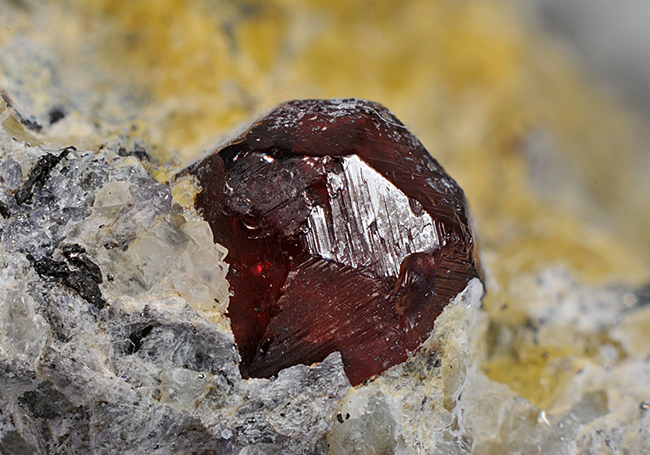REE mineralisation in Spain and Portugal
Economic deposits of REE have not yet been discovered in Spain and Portugal. However, REE enrichments are known in alkaline igneous rocks and carbonatites, and in placers and sedimentary rocks. There is potential for discovery of further REE enrichments in both countries.
Geology of Spain and Portugal
Western Spain (the Iberian massif) and Portugal are characterised by Precambrian to Palaeozoic sedimentary rocks that were metamorphosed and deformed during the Variscan orogeny, and are cut by a number of igneous intrusive phases. These include alkaline igneous intrusions of both Cambro-Ordovician (pre-Variscan) and Late Cretaceous (post-Variscan) age. The Cambro-Ordovician intrusions include the highly peralkaline, REE-enriched Galiñeiro complex (Montero et al. 1998). The Late Cretaceous intrusions are known as the Iberian Alkaline Province, outcropping along the western edge of the Iberian Margin (Miranda et al., 2009). Although significant REE enrichments have not yet been discovered in this province, the alkaline composition of the intrusions makes them an interesting target for further investigation.
Eastern Spain is dominated by Mesozoic to Cenozoic sedimentary rocks, with deformation related to the Alpine orogeny particularly evident in the Pyrenees and Betic Cordillera. Late Cretaceous alkaline igneous rocks, chiefly sills and dykes, are also recognised in the Pyrenees, and Cenozoic alkaline volcanic rocks occur in southern Spain and in the Canary Islands.
REE mineralisation in alkaline igneous rocks and carbonatites
The Galiñeiro Complex is an Ordovician peralkaline intrusion within the Iberian Massif in Spain, composed largely of aegirine-riebeckite gneiss with some amphibole-biotite gneiss. In the north of the complex are patchy areas of hydrothermally altered, fluorine- and thorium-rich ‘radioactive’ albite gneisses. Significant REE enrichments are found in the ‘radioactive’ and aegirine-riebeckite gneisses, with concentrations up to more than 1 wt% total REE, and notable HREE-enrichments. The REE are hosted by REE-carbonates (bastnäsite and parisite), REE-niobotantalates (fergusonite, samarskite, pyrochlore and aeschynite), REE-silicates (allanite, zircon), and REE-phosphates (monazite and xenotime) (Montero et al., 1998).
The Puerto de la Peña-Cueva de Lobos (PP-CL) and Esquinzo Complexes are found within the basal submarine volcanic rocks of Fuerteventura in the Canary Islands. They occur as a series of irregular syenitic and carbonatitic dykes and veins. Rare earth element enrichments are hosted by a series of accessory REE-phosphates, (britholite and monazite), REE-carbonates (bastnäsite), REE-silicates (allanite) and REE-oxides (pyrochlore). The total REE concentration in carbonatites of the PP-CL is approximately 0.74 wt% and about 0.5 wt% in carbonatites of the Esquinzo Complex. The carbonatites at Fuerteventura represent the final stages of magmatic-hydrothermal crystallisation of the submarine alkaline volcanics (Mangas et al., 1997).
REE mineralisation in placers and sedimentary rocks
Significant REE enrichments are associated with radioactive, heavy-mineral rich quartzites in the Vale de Cavalos-Portalegre area of Portugal, which extend across the Spanish border. The Vale de Cavalos quartzites are found in an Ordovician sequence of meta-siltstones and meta-pelites that outcrop in the Portalegre syncline. The quartzites contain abundant zircon and rutile, and minor ilmenite, titanite, magnetite, graphite and dark nodular monazite (Inverno et al., 1998; Oliveira, 1998). Locally, total REE (La, Ce, Nd, Sm, Eu, Tb, Yb, Lu + Sc and Y) concentrations in the most enriched quartzites are in the order of 0.65 wt %. A resource estimate of 2.4 million tonnes, at an average total REE grade of 0.46 wt %, has been suggested by Inverno et al. (1998). These REE enrichments are proposed to result from the diagenesis and low-grade metamorphism of carbonaceous sediments.
The Neogene-aged El Hoyazo Volcanic Complex (EHC) is a very garnet-rich, dacitic dome complex in the Betic Cordillera of Spain. Erosion of the EHC central cone has formed a Quaternary alluvial fan, which contains a significant garnet placer deposit, at the mouth of the Rambla de las Granatillas gorge. The placer is about 1 km2 in area and has a maximum depth of 40 metres. Garnet-rich layers within the placer can be up to 50 centimetres thick and can contain up to 50 per cent garnet by volume. Monazite and xenotime occur as inclusions within the garnet (Martínez-Frías, et al., 2004). Garnet has been exploited from the placer on a small scale, but there has been no assessment of monazite resource.
Key references
Gibbons, W. and T. Moreno (eds). 2002. The geology of Spain. London, Geological Society of London.
Inverno, C M C, Oliveira, D P S, et al. 1998. REE-enriched Ordovician quartzites in Vale de Cavalos, Portalegre, Portugal. Extended Abstracts, Geocongress ’98 – Past achievements/Future challenges, Geological Society of South Africa, 153-157.
Mangas, J., F. J. Pérez-Torrado, et al. 1997. Rare earth minerals in carbonatites of Basal Complex of Fuerteventura (Canary Islands, Spain). Mineral Deposits: research and exploration - where do they meet?
Martínez-Frías, J., R. Lunar, et al. 2004. Th- and U-bearing minerals in the SE Mediterranean margin of Spain. Episodes 27: 33-38.
Miranda, R., V. Valadares, et al. 2009. Age constraints on the Late Cretaceous alkaline magmatism on the West Iberian Margin. Cretaceous Research 30(3): 575-586.
Montero, P., P. Floor, et al. 1998. The accumulation of rare-earth and high-field-strength elements in peralkaline granitic rocks; the Galiñeiro orthogneissic complex, northwestern Spain. The Canadian Mineralogist 36(3): 683-700.
Oliveira, D P S. 1998. The rare earth-bearing Llandeilian quartzites in the Vale de Cavalos-Portalegre area, Central Iberian Zone, Portugal – their better understanding through geological mapping and rock geochemistry. Extended Abstracts, Comunicações Actas do V Congresso de Geologia, Geological Society of Portugal, 142-145.


